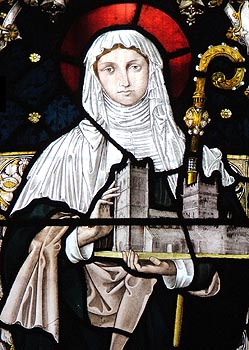
EBK Home
Kingdoms
Royalty
Saints
Pedigrees
Archaeology
King Arthur
Mail David
 St.
Cuthburga,
St.
Cuthburga,Abbess of Wimborne
(Died AD 725)
St. Cuthburga was the daughter of Prince Coenred, a second-cousin of Caedwalla, King of Wessex. Her brothers were St. Ine, King of Wessex and Ingild, great-great-grandfather of
Egbert, the first King of the English, and direct ancestor of
Alfred the Great. Her sisters were St. Cwenburga, Edburga and Tata. Caedwalla became a Christian, in AD 688, and went to Rome to be baptised, resigning the throne to Ine. Cuthburga married Aldfrith, King of Northumbria. He was the illegitimate son of
Oswiu, King of Northumbria, and was educated among the monks of Iona. He was learned in the Scriptures and was a great friend of SS. Adomnan and
Benedict Biscop. They were the parents of Osred, King of Northumbria, and probably of
St. Osana.
Aldfrith and Cuthburga eventually separated for religious motives. Cuthburga took the veil with her sister, St. Cwenburga, at Barking. This nunnery was famous for the zeal of the nuns in the study of sacred and classic literature; and together they became pupils of St. Hildelith, the second abbess. Ine, now King of Wessex, saw that his sisters had devoted themselves to the service of God and was impressed. Desiring to build a church for the good of his soul and the advantage of his people, he had a double monastery erected, between AD 700 and 705, for Cuthburga, at Wimborne in Dorset, near his own residence. Cuthburga was its first abbess. Cwenburga was a nun there with her.
The divided enclosure at Wimborne was rigorously enforced by Cuthburga and not even prelates were allowed into the nuns' quarters. The saintly lady communicated with them through a little hatch. She was kindly to the brethren and sisters under her care, but austere to herself and assiduous in fasting and prayer. Her nunnery soon became the dominant of the two communities and was even more famous than Barking as a training-school for learned and active women. It was from here, in the next generation, that SS. Lioba, Walburga and others, at the call of St. Boniface, joined the great English apostle of Germany and helped in his grand mission. She died at Wimborne on 31st August AD 725 and, when the abbey was destroyed by the Danes about the year AD 900 and afterwards restored, it was dedicated anew in the name of St. Cuthburga and given over to secular canons. St. Cuthburga's chest, hollowed from a single piece of oak, was supposed to have survived the devastation and it is still pointed out in the North Aisle of the Minster. Her burial-place is said to be under the wall of the chancel.
Edited from Agnes Dunbar's "A Dictionary of Saintly Women" (1904).
